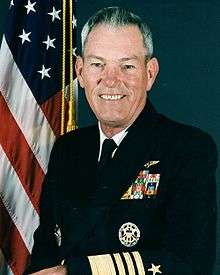Richard C. Macke
| Richard C. Macke | |
|---|---|
 Admiral Richard C. Macke, USN | |
| Born |
January 4, 1938 Freeport, Illinois |
| Allegiance |
|
| Service/branch |
|
| Years of service | 1960-1996 |
| Rank |
|
| Commands held |
U.S. Pacific Command Carrier Group FOUR Carrier Group TWO Naval Space Command USS Dwight D. Eisenhower (CVN 69) USS Camden (AOE-2) VA-66 |
Richard Chester Macke is a retired Naval Aviator and admiral in the United States Navy. He last served as Commander of United States Pacific Command (USPACOM) from July 19, 1994 until January 31, 1996.
Navy career
Macke graduated from the United States Naval Academy with a bachelor of science degree in 1960. After graduation, he reported to flight training in Pensacola, Florida, and was designated a Naval Aviator in August, 1961. He then reported to VA-23 in Lemoore, California and flew A-4 Skyhawks from USS Midway (CV-41).
In 1965, Macke was selected for Test Pilot Training and entered the Navy Test Pilot School at Patuxent River, Maryland. Following graduation, he served in the Weapons System Test Directorate of the Naval Air Test Center, participating in the initial trials of the A-7A, Corsair II aircraft. He next went to VA-27, flying A-7's and completing more than 150 combat missions in Southeast Asia from the USS Constellation (CV-64).
Macke reported to the U.S Naval Postgraduate School in February 1970, where he graduated with distinction with a master of science degree in operations research and systems analysis. In March 1971, he reported to VA-66 at Cecil Field, Florida as Executive Officer and later as Commanding Officer of the A-7E squadron flying from the USS Independence (CV-62).
In January 1975, he was assigned to the Navy Office of Legislative Affairs in the Pentagon, where he was involved in presenting the Naval Aviation Program budget to members of Congress and their staffs. Following completion of Nuclear Propulsion Training, Admiral Macke served as Executive Officer of USS Nimitz (CVN-68), where he participated in the attempted rescue of American hostages in Iran. Completing that tour, he was selected for major ship command and commanded the USS Camden (AOE-2).
Macke served a short tour as the Executive Assistant to the Navy Director of Command and Control in the Pentagon prior to reporting to the nuclear-powered aircraft carrier USS Dwight D. Eisenhower (CVN-69) as Commanding Officer on July 6, 1984. During his highly successful tour on IKE, the ship was awarded the Battle "E" as the most combat-ready aircraft carrier on the East Coast of the United States. Macke relinquished command on October 18, 1986.
Macke was selected for flag rank and reported as the Commander of the Naval Space Command, where he led initiatives to enhance space support to tactical warriors. Next, he reported as the Commander of Carrier Group TWO in March 1988 and in January 1990 was selected for sequential command and became Commander Carrier Group FOUR. Admiral Macke was then nominated by President Bush to serve in the grade of vice admiral as the Director for Command, Control, Communications and Computer (C4) System (J6) on the Joint Staff in the Pentagon. In December 1992, General Colin Powell chose Admiral Macke to serve as the Director of the Joint Staff.
Macke was nominated and confirmed for the four star grade of admiral and left the Joint Staff to become the Commander in Chief, US Pacific Command in July 1994.
1995 Okinawan rape incident
He was fired from his post at PACOM in November 1995, hours after making comments considered insensitive to reporters about the case of U.S. sailors and a Marine accused of kidnapping, beating and raping a 12-year-old Japanese girl: "I think it was absolutely stupid. I have said several times: for the price they paid to rent the car [used in the crime], they could have had a girl."[1]
Macke retired from the Navy April 1, 1996 as a two-star rear admiral, two stars lower than the rank he previously held.[2] Later that year, he was censured by the Navy for matters related to an affair he had before his retirement with an unidentified female Marine Corps lieutenant colonel.
Later life
After his Navy career, Adm. Macke has served as a vice president of Wheat International Communications Corporation.[3]
Involvement in Greenville incident
Macke was also responsible for arranging for the presence of civilians on board the USS Greeneville (SSN-772) prior to its 2001 collision with the Ehime Maru, a Japanese boat carrying high school students.[4] At the request by Macke, a civilian was at the helm of the submarine when the accident occurred. Nine Japanese civilians aboard the Ehime Maru were killed.
Macke refused to testify at the court of inquiry of Commander Scott Waddle, the commanding officer of the USS Greeneville at the time of the accident.
References
- ↑ Fired admiral gives public apology, CNN World News, retrieved November 22, 2010
- ↑ Naval Register, US Navy, retrieved March 21, 2012
- ↑ Admiral Richard C. Macke, TeleSea Wireless Services, archived from the original on July 25, 2006, retrieved March 22, 2012
- ↑ Nathman, Vice Adm. John B.; Sullivan, Rear Adm. Paul F.; Stone, Rear Adm. David M.; Ozawa, Rear Adm. Isamu (April 13, 2001), Court of Inquiry into the Circumstances Surrounding the Collision between USS Greeneville (SSN 772) and Japanese M/V Ehime Maru that Occurred off the Coast of Oahu, Hawaii on 9 February 2001 (PDF), U.S. Navy
External links
- http://www.defenselink.mil/news/Apr1995/m042595_m102-95.html
- The Virginian-Pilot: Admiral who was forced to quit is hired by international firm (March 16, 1996)
| Military offices | ||
|---|---|---|
| Preceded by Harold T. Fields (acting) |
Commander, United States Pacific Command 1994–1996 |
Succeeded by Joseph Prueher |